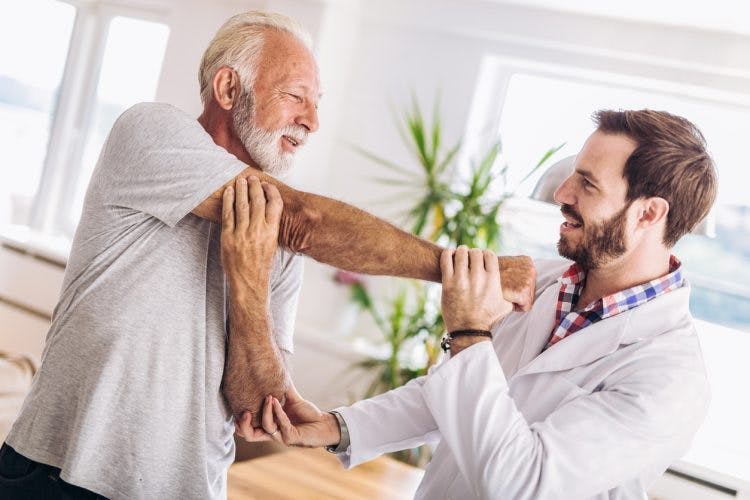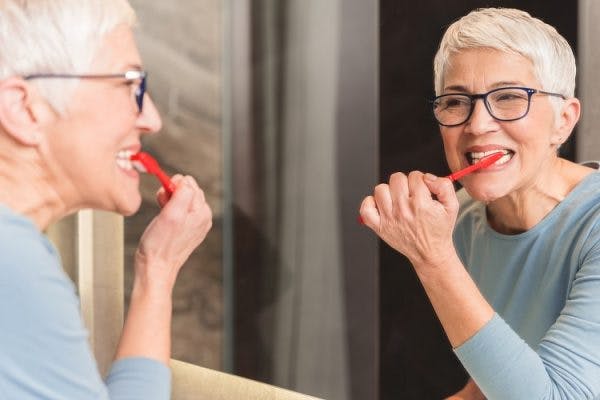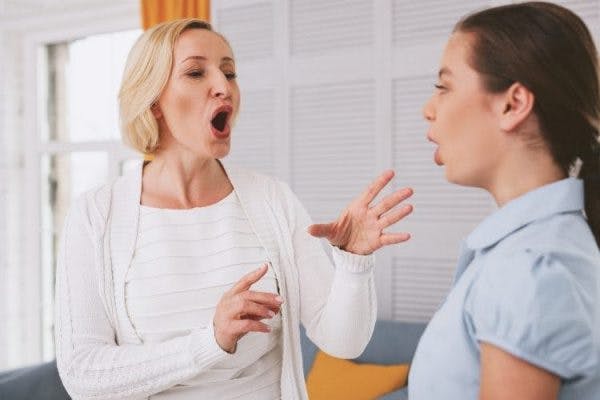The Brunnstrom stages of stroke recovery can help you understand what to expect during life after stroke. Every stroke is different and therefore every stroke recovery timeline is also different. This means that the Brunnstrom approach is more of a guide than an exact recipe.
However, it still helps to understand the various stroke recovery stages because they can help you set meaningful goals and notice the signs of recovery along the way.
Not every survivor starts at stage 1. Rather, survivors may begin their recovery journey at any stage, depending on the severity of their stroke. However, most survivors do progress sequentially from their starting point through the subsequent stages. The idea isn’t to follow the framework from start to finish, but to understand where you are and what the next stage of recovery involves. That way, you can celebrate the signs of recovery without overlooking them, which can help you stay motivated.
Use the links below to jump straight to each stage of the Brunnstrom approach:
- Stage 1: Flaccidity
- Stage 2: Spasticity Appears
- Stage 3: Increased Spasticity
- Stage 4: Decreased Spasticity
- Stage 5: Complex Movement Returns
- Stage 6: Spasticity Disappears
- Stage 7: Normal Function Returns
What Are the Brunnstrom Stages of Stroke Recovery?
Following a stroke, survivors experience various physical and cognitive secondary effects. One of the most common secondary effects following stroke is hemiplegia, or a loss of muscle control on one side of the body. The Brunnstrom approach is a commonly used framework which classifies affected motor functions into stages, along with outlining how muscle control can be restored after a stroke.
The seven Brunnstrom stages were developed in the 1960s by Swedish physical therapist Signe Brunnstrom as a framework to understand motor recovery.
The Brunnstrom approach is unique because of how it views spasticity (muscle stiffness) and involuntary muscle movement. Instead of seeing these as symptoms to fight, the Brunnstrom approach views them as part of the recovery process and utilizes them to aid recovery.
As you dig into each phase of the Brunnstrom stages of stroke recovery, you’ll see how some symptoms, which are often viewed as problematic, can actually signify recovery. This can keep motivation high and trigger a virtuous cycle where more motivation causes survivors to work harder and result in more recovery.
Stage 1: Flaccidity
Quick summary: Flaccidity involves paralysis and “loose, floppy” muscles, which occur on the survivor’s affected side. Rehabilitation should focus on passive exercise during this stage.
Flaccid paralysis is the first stage of recovery. It involves no movement or muscle tone on the affected side, and therefore the muscles appear loose and floppy.
Keep in mind, however, that not all survivors start in stage 1. After a massive stroke, some survivors may start in stage 1; but it’s uncommon for a mild or moderate stroke to cause flaccid paralysis. Therefore, those survivors would not start in stage 1 but would instead start somewhere farther along the Brunnstrom stages of stroke recovery.
For survivors with flaccid paralysis, the best rehabilitation method involves passive range-of-motion exercises. Range-of-motion exercises involve moving or stretching the muscles along a specific joint safely and painlessly. Since survivors with flaccid paralysis are unable to actively move their affected muscles on their own, they can use their unaffected side or rely on a therapist or trained caregiver to passively move their limbs through these exercises.
Passive exercise is a powerful treatment for survivors with flaccid paralysis because it helps stimulate the brain and spark neuroplasticity, the mechanism the brain uses to rewire itself and heal after stroke. This helps maximize your chances of recovering movement after post-stroke paralysis.
Proper positioning of flaccid limbs is also very important, so have a therapist in the hospital educate you regarding this, too.
Stage 2: Spasticity Appears
Quick Summary: Spasticity involves muscle stiffness after stroke, and it’s actually a sign of recovery because it’s an improvement from flaccidity where the muscles have no tone at all.
When the brain and muscles begin to reconnect through neuroplasticity, this is good news. It means recovery is happening! However, when the connection is weak, your brain is unable to coordinate movement. The signals that tell your muscles when to contract and when to relax are interrupted, and as a result, they may stay contracted.
This prolonged, involuntary state of muscle stiffness after stroke is known as spasticity, the second phase of the Brunnstrom stages of stroke recovery. At this stage, spasticity causes the muscles to become resistant when completing passive range-of-motion exercises. While spasticity can be uncomfortable and limit your range-of-motion, it’s actually a sign of recovery from stroke. It means that some connection exists between the brain and affected muscles, and now is the time to keep pursuing recovery.
To treat spasticity, continue practicing passive exercises on a consistent basis to keep neuroplasticity stimulated. Even if you can only move a small amount, it’s important to keep putting in the repetition and consistency necessary to activate neuroplasticity and promote recovery.
Stage 3: Spasticity Increases
Quick Summary: When spasticity increases, it can be discouraging but it also signifies continued recovery. Pursue a mix of active and passive exercise to help address spasticity.
At the third stage, spasticity reaches its peak. Muscle stiffness may become severe and, if left untreated, may cause contractures, a condition where the joints become frozen and immobile.
To continue treating spasticity and reduce the risk of contractures, keep diligently practicing your passive and active rehabilitation exercises. Even though it might seem like your muscles are not improving, but rather are worsening when you reach this stage, do not give up! The increased spasticity should actually be seen as a good thing, because it means the neural connections between your brain and muscles are improving.
Sometimes, when spasticity increases too much, it limits your ability to exercise because the limbs are too stiff to move. If your doctor approves, you may be able to receive Botox injections to temporarily relieve spasticity, especially if it causes pain. Make sure you continue therapy exercises after your injection to optimize its effects.
Since Botox only treats the symptoms of spasticity, it is just a temporary solution. However, it can provide enough temporary mobility to practice your rehab exercises and spark continued neuroplasticity. Splinting, braces, or other gloves for stroke patients can also be helpful for spasticity, so speak with your therapists about this.
Stage 4: Spasticity Decreases
Quick Summary: With enough hard work, spasticity begins to decrease and more coordinated movement emerges. A rigorous home therapy program can help keep recovery going.
If you continue to practice your rehab exercises, spasticity may start to decrease, marking the fourth stage of the Brunnstrom stages of stroke recovery. You’ll start to regain control of your muscles and begin to make more coordinated voluntary movements. Oftentimes, the larger muscles of your arms and legs begin to recover first, followed by the smaller muscles within your hands and feet.
At this point, you should continue with your rehabilitation exercises to keep neuroplasticity activated. You can also add strengthening exercises to address any loss of strength that occurred during previous stages of limited mobility.
Also, in order to keep recovery going, it’s important to find a motivating at-home therapy program. You can ask your therapist to send you home with a sheet of exercises to practice. If you struggle to stay motivated, you can look into gamified neurorehab devices like Flint Rehab’s FitMi, which turns conventional therapy exercises into an interactive, engaging experience.
FitMi encourages users to accomplish hundreds of repetitions per session, which helps maximize neuroplasticity and improve movement after stroke. Best of all, it can be used passively or actively, depending on which stage of recovery you’re in.
Stage 5: Complex Movement Returns
Quick Summary: After movement returns to the arms and legs, it begins to improve in the hands and feet.
At this stage, you should be able to make more controlled and deliberate movements, such as combing your hair and picking up a fork on your own. Spasticity may still be present but it will be mild and not restrict your movement as much. Furthermore, fine motor movements may improve too.
The hands and feet are often the slowest functions to recover after stroke because they are farthest from the midline of the body. As such, you can target these muscles with hand exercises or foot drop exercises.
This is also the stage where synergistic movement should improve. Synergistic movement involves unintentionally linked movements. For example, some survivors unintentionally hike their shoulder when attempting to move their arm.
At the fifth stage of the Brunnstrom approach, synergistic movement should be improving or even gone as more complex, coordinated movement returns.
Stage 6: Spasticity Disappears
Quick Summary: Once spasticity is gone, survivors can focus on both strength and coordination exercises.
Once you reach stage six, spasticity disappears entirely and motor control is almost fully restored. You are also able to move individual joints without any synergistic movement.
At this stage, you can pursue a mix of strength and coordination exercises. You can also get back to any beloved hobbies that involve full body motion, such as swimming, tennis, or hiking. The more you practice moving, the more you will continue to improve.
Stage 7: Normal Function Returns
Quick Summary: The last phase of the Brunnstrom stages of stroke recovery involves a full recovery of muscle function.
Many survivors find themselves wondering, is a full recovery from stroke possible? Because every stroke is different, every recovery is also different. While no doctor or therapist can predict who will achieve a full recovery, one thing is clear: survivors that pursue rehabilitation with consistency and dedication often see more gains than those who stop therapy after they hit a plateau.
Stroke recovery is not a linear process and often involves taking two steps forward and one step back. It’s important to keep things in perspective. Sometimes that step backwards is actually just the transition from stage 2 (spasticity appears) to stage 3 (spasticity increases). In other words, even a step backwards can be a sign of progress sometimes!
Not all survivors will reach stage seven, but many can with enough hard work and dedication. At this stage of the Brunnstrom approach, you can voluntarily move your body with strength and coordination just as you did before your stroke. This is a massive achievement that deserves celebrating just as much as the smaller milestones along the way.
Viewing Recovery as a Process: The Brunnstrom Stages of Stroke Recovery
The Brunnstrom stages of stroke recovery provide not only a framework for the recovery process, but also hope. When symptoms appear to worsen after a stroke, it can cause survivors to lose motivation and, as a result, stop pursuing recovery.
However, sometimes what seems like a step backwards is actually a sign of progress. This is why it’s helpful to understand how spasticity progresses throughout recovery via the Brunnstrom approach.
The best way to maximize your chances of reaching stage 7, or a full recovery, is to practice rehabilitation exercises on a daily basis. Whether you need to practice your exercises passively or actively, the goal is to practice with consistency to keep the neuroplasticity stimulated.
With enough time and hard work, you just might see yourself progressing through the Brunnstrom stages of stroke recovery, and that is worth celebrating.










